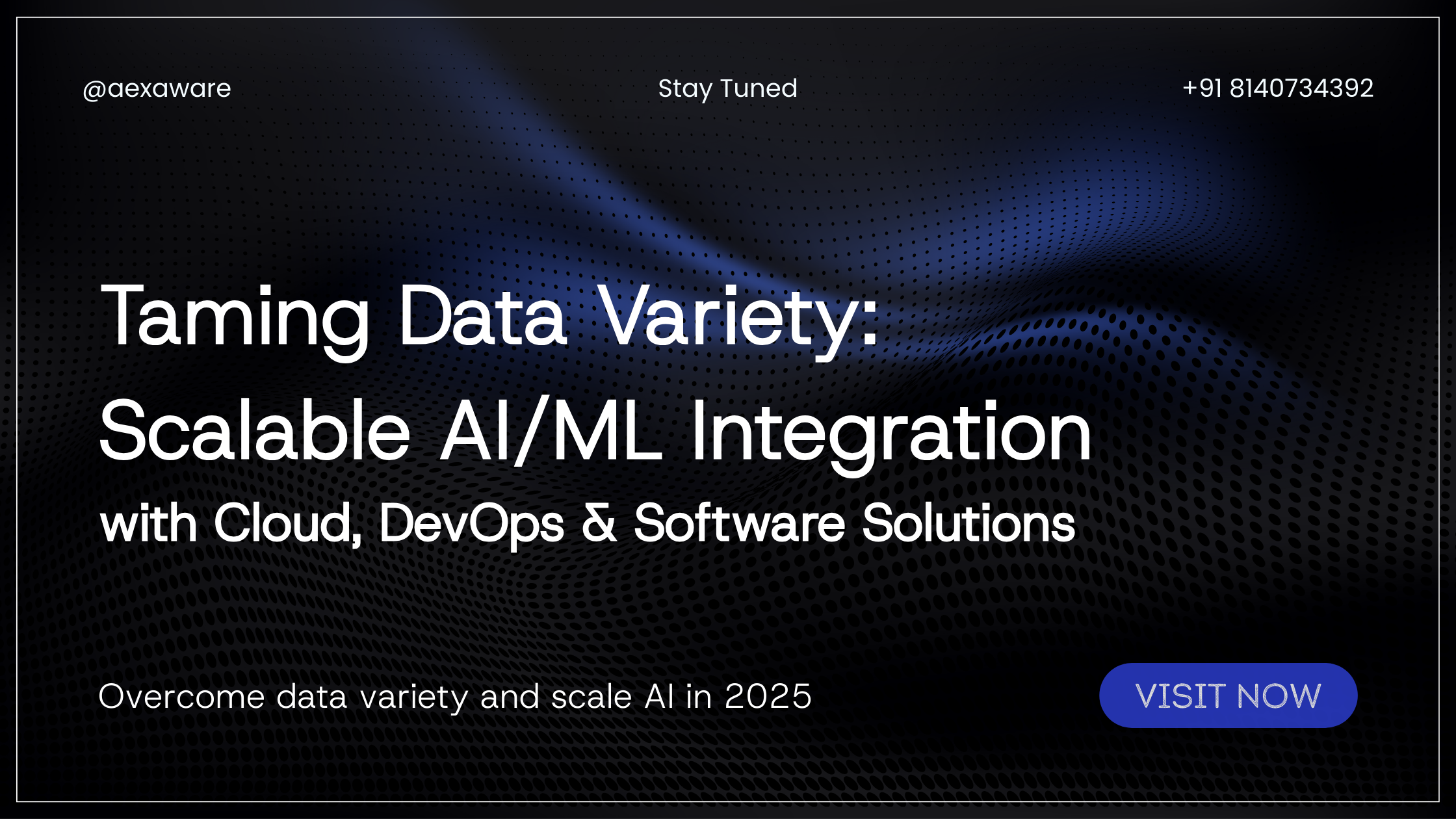Struggling to scale AI in 2025? You’re not alone. Independent analyses continue to show a high failure rate for AI initiatives many never make it past pilots or are scrapped entirely often due to messy, fragmented data and weak production pipelines.
This guide explains how Aexaware Infotech helps you turn data chaos into production-grade AI by unifying your systems, building cloud-native pipelines with DevOps/MLOps, and shipping software and interfaces people actually use.
Why AI Projects Stall: It’s (Mostly) Data Variety
Data variety is the spread of structured (databases/transactions), semi-structured (JSON, XML, logs), and unstructured data (emails, documents, media, sensor/IoT) across countless sources. When formats, schemas, and systems clash, models can’t learn consistently and pipelines break.
Common symptoms:
- Disconnected tools (ERP/CRM/e-commerce/mobile/legacy).
- Inconsistent file formats and evolving schemas.
- Duplicates, missing values, and conflicting semantics.
- Models that look good in notebooks but never reach stable production.
Bottom line: Data variety more than algorithms decides whether your AI scales beyond a pilot. Peer-reviewed work and industry research highlight heterogeneous data integration as a primary engineering challenge for AI.
What “Good” Looks Like: Cloud + DevOps + MLOps
Scaling AI isn’t just “deploying a model.” It’s standing up versioned, testable, and automated pipelines for data, features, training, deployment, and monitoring CI/CD/CT for ML so you can retrain and ship safely as data and business rules change.
Aexaware’s reference approach
- Data Integration Layer (Custom Software)
- APIs, connectors, and middleware unify web, mobile, and enterprise apps.
- Data contracts and validation to prevent schema surprises.
- Incremental ingestion & change data capture (CDC) for reliability.
- Cloud & DevOps
- Containerized services, infrastructure as code, and secure secrets.
- CI/CD for data pipelines and ML jobs; policy-as-code for compliance.
- Observability across ingestion, transformation, training, and inference.
- MLOps
- Feature stores, experiment tracking, model registries, and blue/green or canary deploys.
- Continuous training (CT) and automated retraining triggered by data drift.
- Real-time inference and streaming integrations when the business needs it.
- UI/UX & Apps
- Human-centered dashboards for data quality & model health.
- Mobile & web apps that surface predictions at decision time (not after the fact).
Step-by-Step: Taming Data Variety (Technical Walkthrough)
1) Inventory & Classify Data Sources
- Catalog sources by type (structured/semi/unstructured), owner, refresh cadence, sensitivity, and intended AI use.
- Prioritize “high-value, high-pain” sources to stage quick wins.
- Define data contracts (schemas, SLAs, semantics, PII flags) with producers and consumers to stabilize interfaces.
2) Land → Stage → Validate
- Land raw data in a secure lake/lakehouse; keep immutable raw zones.
- Validate with contract checks (schema, nulls, ranges, referential rules) before promotion.
- Keep lineage and audit trails for compliance and debugging.
3) Handle Schema Evolution (Without Fire-Drills)
- Plan for evolving schemas; adopt lakehouse tech that supports schema enforcement + evolution to avoid brittle pipelines as fields appear, rename, or deprecate.
4) Build Reusable Features & Training Pipelines
- Create feature definitions with tests and documentation.
- Automate training with CI/CD/CT so new data → validated features → retrained model → staged deployment.
5) Deploy, Monitor, Improve
- Productionize with A/B or canary, monitor data drift & model performance, set rollback triggers.
- Close the loop with feedback into your product backlog (UX and ops included).
Real-World Example (Anonymized)
A mid-size retail chain wanted demand forecasting, but data lived in POS systems, a mobile app, and spreadsheet-driven supply workflows. We:
- Built middleware & APIs to unify sources and added data contracts.
- Moved pipelines to the cloud; added CI/CD + observability.
- Implemented a feature store and automated retraining with monitored rollouts.
Results:
40% fewer stockouts, 30% faster reporting, and more accurate forecasts leading to higher on-shelf availability (and happier customers).
Why This Matters in 2025
- Adoption is up, value is uneven. Many firms use AI, but production value requires robust data foundations and engineering discipline.
- Costly restarts. A growing share of organizations reports scrapping AI initiatives strong signal that integration (not algorithms) is the blocker.
How Aexaware Infotech Helps
- 🌐 Website Development – Customer-facing touchpoints integrated with your data and models.
- 📱 Mobile App Development – Real-time insights in the hands of field teams and customers.
- 🛠 Custom Software Solutions – APIs, connectors, and middleware that unify data sources.
- ☁️ Cloud & DevOps Services – Automated, secure, and scalable pipelines.
- 🤖 AI/ML Integration Services – Feature stores, training pipelines, and safe model releases.
- 🎨 UI/UX Design – Dashboards for data quality, drift, and business KPIs that build trust.
With Aexaware, you don’t just “add AI” you ship AI that survives data variety and scales in production.
FAQs
Q1: Why do most AI projects fail?
Because data is inconsistent, fragmented, and poorly integrated not because models are “weak.” Studies show a large share of initiatives fail to reach production or are later scrapped when pipelines and governance aren’t in place.
Q2: How does DevOps/MLOps improve AI/ML integration?
DevOps and MLOps bring CI/CD/CT to ML: automated testing, retraining, deployment, and monitoring so models update safely as data and requirements evolve.
Q3: Which services are essential for successful AI adoption?
Custom software + cloud DevOps + MLOps + UI/UX + apps. Together they solve integration and visibility the true blockers to production value. (See above.)
Ready to scale AI without the data headaches?
Aexaware Infotech can assess your data landscape, stabilize pipelines, and get your models reliably into production.
→ Book a free consultation today.
Error: Contact form not found.




